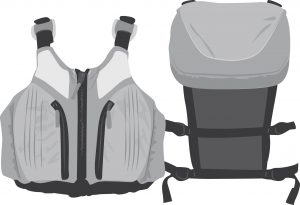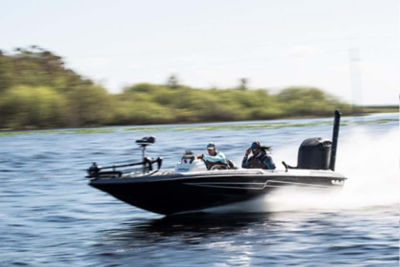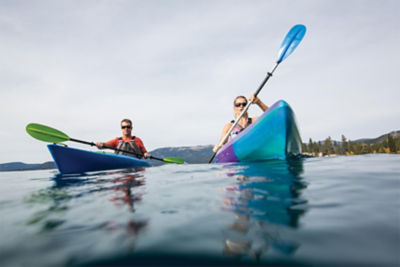How to Buy a Life Vest
From fishing to kayaking and tubing to swimming, suit up for the water with the proper life vest for your outing.

A life jacket is essential for anyone taking part in water activities, including recreational boating, kayaking, tubing or canoeing. Life vests, also called Personal Flotation Devices, are worn like a jacket and typically have a zipper or a buckle closure. Activity-specific life vests provide the highest levels of safety.
FISHING LIFE VEST
- Able to be comfortably worn in a kayak or canoe. The wider cuts around the arms make it easy to paddle your boat.
- Allows for freedom of movement. Easy to cast and reel.
- Generally offers multiple tool hangers, loops for your fishing rod and pockets for other fishing accessories.
- Typically a Type III PFD.
KAYAKING & CANOEING LIFE VEST
- Allows for freedom of movement with wider cuts around the arms. Easy to paddle.
- Paddle sport vests typically have a thinner nylon backing to ensure comfort when seated in a kayak.
- Typically a Type III PFD.
COMPLIANCE VEST
- Simple, durable vests that are compliant with United States Coast Guard regulations for all types of recreational boating.
- Commonly a foam device with a single strap to ensure a secure fit.
- Typically a Type II PFD.
WATER SKIING & WATER TUBING LIFE VEST
- WatSnug fitting vest with wide-cut arms for easy movement while water skiing, water tubing, kneeboarding, wakeboarding, or snorkeling.
- Most commonly foam vests with buckles to ensure a comfortable, tight fit.
- Typically a Type III PFD.
YOUTH LIFE VESTS
- Typically one-size fits all. Made for children between 50-90 pounds.
- Designed for recreational boating and paddle sports.
- Comfortable fit for both girls and boys.
TODDLER LIFE VESTS
- Typically one-size fits all—specified for children between 30-50 lbs.
- Can be used in most all water situations from learning how to be comfortable in the water to recreational boating.
- Comfortable fit for both boys and girls.
INFANT LIFE VESTS
- One-size fits all. Accommodates infants up to 30 pounds.
- Shorter cut helps new swimmers can maneuver with ease and comfort.
- Generally comes with a simple zipper and two buckles to ensure maximum safety for your child.
LIFE VEST DEFINITIONS
Type I PFD - Off-Shore Life Jacket
- Foam = 22 pounds of flotation
- Commercial style, reversible, easy to put on
- Provides the most buoyancy
- Effective for all waters - especially where rescue may be delayed
- Designed to turn most unconscious wearers to a face-up position in the water
Type II PFD - Near-Shore Buoyancy Vest
- Foam = 15.5 pounds of flotation
- Inflatable = 33.5 pounds of flotation
- Intended for calm, inland water or where a quick rescue is possible
- Will turn some unconscious wearers to a face-up position in the water (turning is not as definite as with a Type I PFD)
Type III PFD - Flotation Aid
- Foam = 15.5 pounds of flotation
- Inflatable = 22.5 pounds of flotation
- Both lightweight and comfortable
- Good for conscious wearers in calm, inland water or where a quick rescue is possible
- Designed so wearers can place themselves into a face-up position in the water (wearer may have to tilt head back to avoid flipping over)
- Type III foam vest offers same minimum buoyancy as Type II PFD
- Comes in many colors and sizes and is most comfortable for continuous wear
Type IV PFD - Throwable Device
- 16 to 20 pounds of floatation
- Intended for calm, inland water with heavy boat traffic wear rescue is always possible
- Designed to be thrown to a conscious person in the water to be held by user until rescued
- Not to be worn
- Type IV devices include buoyant cushions, ring buoys and horseshoe buoys
- Should be used in conjunction with a wearable life jacket
Type V PFD - Special Use Device
- Intended for specific activities
- Should only be used in accordance with the approval condition(s) on its label
LIFE VEST MATERIALS
Another aspect to consider when purchasing the right life vest is the material. The two most common types of materials are nylon and neoprene.
Nylon
- Most common material found in paddle sport life vests.
- Less expensive type of fabric.
- Light material—makes it easy and comfortable for the user to paddle their boat or cast their fishing reel.
Neoprene
- Most common material found in water sport vests (skiing, tubing, kneeboarding, etc.).
- More expensive type of fabric.
- Provides a comfortable, snug fit with higher amounts of buoyancy to keep the user afloat.
LIFE VEST SIZING AND FITTING
A life vest should fit comfortably and be worn for its specific use. Life vests come in adult, youth, child and infant sizes. Keep these factors in mind when making your selection:
- Choose a life vest based on chest size for adults and weight for children.
- Loosen all straps, put it on, and secure closure.
- Tighten all straps, starting with the waist belt, and work your way up to the shoulder straps.
- Pull vest up from shoulder straps. If the life vest pulls up around the paddler’s head, the vest is too big.
- Try some paddling moves to ensure full range of motion so that no binding or chafing occurs.
The last two guidelines are to be used when fitting a life vest for paddle sports. In general, a life vest should fit securely and comfortably for all types of users. If your vest is too loose, it will not provide proper flotation in water.












